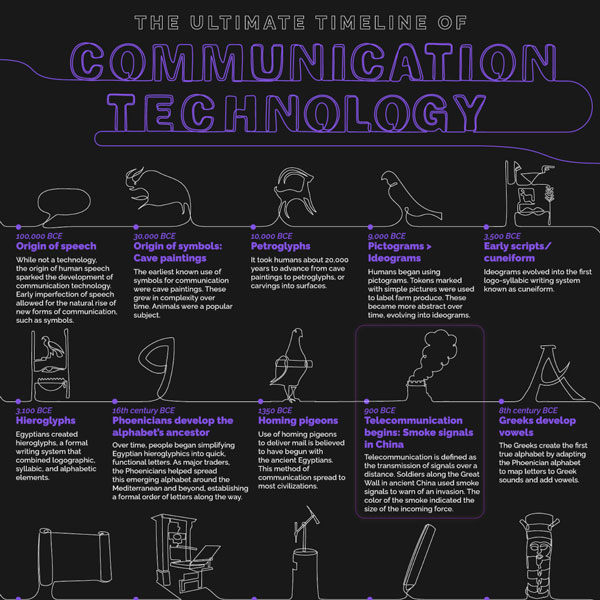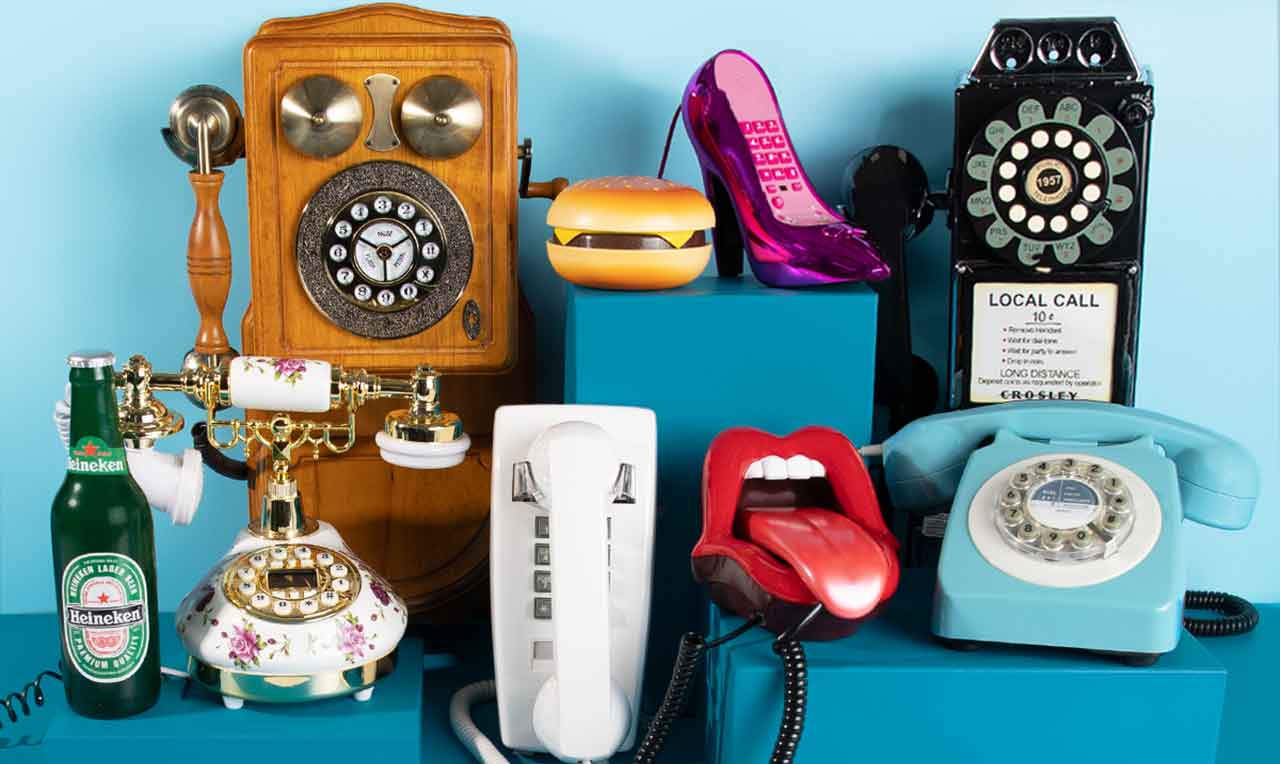The ultimate timeline of communication technology

Since the dawn of humanity, people have been discovering and inventing new methods to communicate. From smoke clouds to cloud storage, the evolution of communication technology has been beyond the wildest imaginations of our ancestors. The team at Ooma is proud to present this ultimate timeline of communication technology, tracing back all the way to the origin of speech. You will discover the origin of the telephone, when computers were invented, the first email sent and so much more! Without further ado, let’s dial in.

When was the telephone invented?
The first practical telephone was patented in 1876, but the true origins of the telephone are a bit shrouded in controversy. Scottish-born Canadian-American inventor Alexander Graham Bell is credited with being the inventor of the telephone. However, the idea and design do not wholly belong to him.
So, who was the true inventor of the telephone? While Alexander Graham Bell is described as the “father of the telephone,” it was actually an Italian immigrant named Antonio Meucci who first developed the concept and design for a talking telegraph (or telephone) in 1849. Just four years before Bell patented his telephone design, in 1871, Meucci filed a caveat (or an announcement of an invention) for his design of a talking telegraph. Unfortunately, Meucci could not afford to renew the patent on his design, so his role in the invention of the telephone is often overlooked. Worry not, there was some justice! On June 11, 2002, the United States House of Representatives passed a resolution honoring Meucci’s contributions.
The story of who invented the telephone gets even more murky. American electrical engineer Elisha Gray filed a patent for his telephone design on February 14, 1876, the same day that Bell’s lawyers filed his patent. No one truly knows what occurred between Bell’s lawyers and the patent officers on that day, but the patent was ultimately awarded to Bell. Over the following weeks, Bell improved upon his version of the telephone with features that were remarkably similar to those illustrated in Gray’s preliminary patent application. However, Ellis Spear, a senior official at the patent office, denied any interference between Gray and Bell’s applications. This situation calls to mind the Sivowitch Law of Firsts, which dictates that “whenever you prove who was first, the harder you look you will find someone else who was more first.”
The first phone call ever made was on March 10, 1876, just three days following the publication of Bell’s telephone patent. Alexander Graham Bell made history when he successful conveyed this message to his assistant Thomas Watson: “Mr. Watson, come here — I want to see you.” While the words were crackly and indistinct, they were the first to be spoken over the telephone.
So did Bell really invent the telephone? That is up to you to decide. Either way, phones have become an integral part of how we live, work and play!
When was the mobile phone invented?
On April 3, 1973, Motorola researcher and executive Martin Cooper made the first mobile phone call to his rival Dr. Joel S. Engel of Bell Labs. Standing on a Sixth Avenue sidewalk in Manhattan, he called Engel via a device the size of a brick and said: “I’m calling you on a cell phone, but a real cell phone, a personal, handheld, portable cell phone.” So, does this answer the question, “What was the first mobile phone?” Unfortunately, government regulation and manufacturing issues slowed the progress of bringing the phone to market. It took a decade for a version of that Motorola DynaTAC (Dynamic Adaptive Total Area Coverage) phone to become commercially available. And how much did the first cell phone cost? At the time, the Motorola DynaTAC cost a staggering $3,995! In today’s economy, that equates to around $12,600.
When was the internet invented?
January 1, 1983 is widely considered to be the official birthday of the internet. Prior to this world-transforming day, there was no standardized way for computers to communicate with each other. A new electronic communications standard called the Transmission Control Protocol/Internet Protocol (TCP/IP) provided a universal language for computers, enabling them to communicate with each other. ARPANET (the predecessor of the internet) and the Defense Data Network officially switched over to the TCP/IP standard on January 1, 1983, marking it as the official birth of the internet.
Who invented the TCP/IP model?
The Transmission Control Protocol/Internet Protocol was developed by Robert E. Kahn and Vinton G. Cerf, computer scientists working for Defense Advanced Research Projects Agency. They developed an internet architecture that allowed various networks (and their connected devices) to exchange data packets in a shared, standardized language. In 2004, Kahn and Cerf received the Turing Award for their work as internet pioneers. Without this foundational work, our home phone, business phone and business internet services would not exist!
We mentioned ARPANET being the predecessor of the internet before, but what is ARPANET exactly? ARPANET stands for the Advanced Research Projects Agency Network. It was a revolutionary computer networking project operated by the United States Department of Defense and ultimately paved the way for the internet we know today. Initially, ARPANET was designed to allow communication and information sharing between government agencies and research institutions. ARPANET introduced packet-switching technology, which allowed data to be broken down into smaller packets that could be exchanged across a decentralized network.
Read on for our full timeline of communication technology:
Time and Event | Description |
|---|---|
100,000 BCE Origin of speech | While not a technology, the origin of human speech sparked the development of communication technology. Early imperfection of speech allowed for the natural rise of new forms of communication, such as symbols. |
30,000 BCE Origin of symbols: Cave paintings | The earliest known use of symbols for communication were cave paintings. These grew in complexity over time. Animals were a popular subject. |
10,000 BCE Petroglyphs | It took humans about 20,000 years to advance from cave paintings to petroglyphs, or carvings into surfaces. |
9,000 BCE Pictograms > Ideograms | Humans began using pictograms. Tokens marked with simple pictures were used to label farm produce. These became more abstract over time, evolving into ideograms. |
3,500 BCE Early scripts/cuneiform | Ideograms evolved into the first logo-syllabic writing system known as cuneiform. |
3,100 BCE Hieroglyphs | Egyptians created hieroglyphs, a formal writing system that combined logographic, syllabic and alphabetic elements. |
16th century BCE Phoenicians develop the alphabet’s ancestor | Over time, people began simplifying Egyptian hieroglyphics into quick, functional letters. As major traders, the Phoenicians helped spread this emerging alphabet around the Mediterranean and beyond, establishing a formal order of letters along the way. |
1350 BCE Homing pigeons | Use of homing pigeons to deliver mail is believed to have begun with the ancient Egyptians. This method of communication spread to most civilizations. |
900 BCE
Telecommunication begins: Smoke signals in China | Telecommunication is defined as the transmission of signals over a distance. Soldiers along the Great Wall in ancient China used smoke signals to warn of an invasion. The color of the smoke indicated the size of the incoming force. |
8th century BCE Greeks develop vowels | The Greeks create the first true alphabet by adapting the Phoenician alphabet to map letters to Greek sounds and add vowels. |
105 CE Ts’ai Lun invents paper | Han Dynasty court official Ts’ai Lun invents a papermaking process that turns textile waste into paper. |
1440 Printing press | German goldsmith Johannes Gutenberg invents the mechanized movable-type printing press, launching the Printing Revolution. |
1794 Optical telegraph | Claude Chappe develops the optical telegraph (or semaphore telegraph), a line of stations that could convey messages through indicator flags or light reflections. |
1795
Pencil | French artist Nicolas-Jacques Conté mixes powdered graphite and clay and presses it between two half-cylinders of wood, inventing the modern pencil. |
18th century Talking drums | Yoruba drummers use talking drums to mimic human tonal language, enabling them to communicate complex messages over 4-5 mile distances. |
1821 Heliotroph | German professor Carl Friedrich Gauss develops heliotrophs, the predecessor for heliographs, a telegraph system using flashes of solar light and mirrors. |
1827
First photograph | French physicist Joseph-Nicéphore Niépce captures the first photograph using heliography, a process in which solar energy is burned onto a chemical-treated film material, creating an image. |
1837
Electric telecommunication begins with the Cooke and Wheatstone system | British inventors William Cooke and Charles Wheatstone patent the first electric telegraph. |
1838
Electrical telegram and Morse Code | American artist Samuel Morse, chemist Leonard Gale and engineer Alfred Vail demonstrated an electrical telegram using a forerunner to today’s Morse code. |
1843 Electric printing telegraph (fax predecessor) | Scottish inventor Alexander Bain patents an early fax machine which translated images on a flat metal surface via a pendulum-mounted stylus. |
1844 First electric telegraph message sent | Samuel Morse sends this first ever electric telegraph between Washington, D.C., and Maryland: “What hath God wrought!” |
1844 Paper is produced from wood pulp | Canadian Charles Fenerty invents the wood pulp process for papermaking. By the 1900s nearly all western world newspapers switched to pulp wood newsprint. |
1849 First telephone is designed | Italian immigrant Antonio Meucci began developing the first telephone design, but he could not afford to renew his 1871 caveat (an announcement of an invention). |
1865 International Morse code | The International Morse code was standardized by the International Telegraph Convention in Paris in 1865 and adopted later by the International Telecommunication Union. |
1876 First practical telephone | Alexander Graham Bell patents his functional telephone after several years of experimentation (and possible plagiarism of other acoustic telegraph patents). |
1876 First telephone call | Alexander Graham Bell successfully calls his assistant in another room. |
1887 Radio waves discovery | German physicist Heinrich Hertz proves the existence of electromagnetic waves. |
1895 First wireless Morse code sent | Italian inventor Guglielmo Marconi successfully sends the first wireless Morse code message to a source over a kilometer away. |
1896 First wireless telegraph | Marconi files a patent for his wireless telegraphy system. |
1897 First radio broadcast | Marconi successfully sends a radio message across the Bristol Channel, the first time a broadcast was made across open waters. |
1906 First music radio broadcast | On Christmas Eve, Canadian physicist Reginald A. Fessenden broadcasts “O’ Holy Night” to the awestruck crews on ships across the Atlantic from Massachusetts. |
1920
First commercial broadcast | Station KDKA makes the first commercial broadcast to announce the results of the Harding-Cox presidential race. |
1927 Television | American inventor Philo Farnsworth demonstrates and patents his “dissector tube,” a device that would make television possible. |
1927
First video call | Bell Labs connects Secretary of Commerce Herbert Hoover with AT&T president Walter Gifford via a one-way video connection (with two-way audio). |
1928 First television drama | The Queen’s Messenger is broadcast from Schenectady, New York station W2XAD. |
1929
First commercially available TV | The Baird “Televisor” sells about 1,000 units, costing 26 British pounds. |
1936 First live television broadcast | Telefunken live broadcasts the Berlin Summer Olympic Games using new technology developed by RCA. |
1937 Walkie-Talkie | Engineer Donald Hings equips the British and Canadian militaries with the first version of a portable two-way wireless radio. |
1938 First commercially-successful ballpoint pen | Frustrated by the inefficiency of fountain pens, Hungarian newspaper editor László Bíró develops a quick-drying ink and ball-socket mechanism that would revolutionize pens. |
1937 Electrophotography | Struggling with arthritis, patent attorney Chester Carlson invents electrophotography to make the process of creating copies easier. |
1941 First TV commercial ad runs | An ad for the watchmaker Bulova before a baseball game becomes the first TV commercial ever. The placement cost $9. |
1945 First digital computer | The ENIAC (Electronic Numerical Integrator and Computer) becomes the first programmable, electronic, general-purpose computer. It filled a room. |
1949 First pager | Engineer Al Gross patents the first telephone pager. The New York City Jewish Hospital starts using them in 1950. |
1951 Videotape recorder | Ampex Corporation researcher Charles Ginsberg invents the videotape recorder, a device which converts live images into electrical impulses stored on magnetic tape. |
1954 First RCA color television set | RCA produces the CT-100, its first color TV set, which cost $1,000 and had a 12-inch screen. |
1956 First commercially available videotape recorder | The Ampex VRX-1000 hits the market for $50,000. |
1959 First commercially successful copier machine | The Xerox 914 became the first successful copier machine, revolutionizing the industry. |
1964 First commercial modern fax machine | Xerox introduces LDX (Long Distance Xerography), the first version of the fax machines we know today. |
1969 Internet age begins: ARPANET | The Advanced Research Projects Agency and the United States Department of Defense create the first computer network. |
1970 First commercial videotelephone system | AT&T launches Picturephone, a subscription service that ultimately failed due to lack of interest. |
1971 First personal computer | John V. Blankenbaker’s Kenback-1 sells for $750 USD, or around $6,000 in today’s currency. |
1971 First email | Engineer Ray Tomlinson sends the first email between two different computers on the ARPANET. |
1973 First mobile phone call made | Motorola researcher Martin Cooper successfully calls his rival at Bell Labs, saying: “I’m calling you on a cell phone, but a real cell phone, a personal, handheld, portable cell phone.” |
1976 First word processor | Electric Pencil was created by Michael Shrayer, a former cameraman, producer and director of TV commercials and films. |
1979 First commercial cellular network (1G) | Nippon Telegraph and Telephone (NTT) launches the first commercial cellular network in Japan. |
1981
First laptop | The Osborne 1 becomes the first commercially successful portable computer, costing $1,795. |
1983 Birth of the internet | A new communications standard called Transfer Control Protocol/Internet Protocol (TCP/IP) is established, connecting computers with a universal language. ARPANET and the Defense Data Network officially shifted to this standard. |
1984 First commercially available mobile phone | The Motorola DynaTAC 8000X becomes available for $3,995. |
1988 First instant messaging system | IRC (Internet Relay Chat) becomes the first instant messaging system. It is still in use today. |
1989 World Wide Web | British scientist Tim Berners-Lee invents the World Wide Web, which was initially intended for information-sharing between universities and scientific institutes. |
1990 First search engine | McGill University student Alan Emtage creates Archie, the first search engine. It used a script-based data gatherer to retrieve file names that matched a user query. |
1991 Second-generation (2G) cellular technology | 2G is commercially launched in Finland by Radiolinja using the GSM (Global System for Mobile communications) standard. |
1991 Webcam | The first webcam streams the Trojan Room coffee pot at the University of Cambridge’s Computer Laboratory. |
1992 First text message | Engineer Neil Papworth sends the text message “Merry Christmas” via the Vodafone network to a colleague. |
1993 World Wide Web goes public | CERN (European Council for Nuclear Research) put the World Wide Web in the public domain. |
1993 First popular graphical web browser | Mosaic becomes the first web browser to display graphics in line with text, instead of a separate window. |
1994
First smartphone | IBM’s Simon Personal Communicator becomes commercially available. It was equipped with a touch screen and other visionary applications like an address book, calendar and calculator. |
1996 PalmPilot 1000 | The first Palm device is released, a personal digital assistant (PDA) and mobile phone developed by Palm, Inc. They are remembered as the first wildly popular handheld computer and helped usher in the age of smartphones. |
1997 First free U.S. instant messaging system | AOL Instant Messenger (AIM) allows users to send free instant messages on the internet. |
1997 Wi-Fi | Wi-Fi®, a family of wireless network protocols, uses radio waves for local area networking of devices and access to the internet. |
1997 First social media | SixDegrees.com becomes the first true social media site. You could set up a profile, create connections and send messages within networks. |
1998 | Computer scientists Larry Page and Sergey Brin launch Google, which would become the most widely used search engine. |
1999 BlackBerry 850 | First two-way pager that integrated email capabilities. The name was chosen out of 40 potential contenders because of the resemblance of the keyboard buttons to the drupelets of blackberries. |
1999 First satellite radio | Ethiopian-founded WorldSpace broadcasts in Africa and the Middle East via satellite. |
1999 First peer-to-peer file sharing system | American college student Shawn Fanning launches Napster, which allows users to share and save electronic copies of music over the internet. |
1999 “Internet of Things” is coined | Computer scientist Kevin Ashton coins the term “Internet of Things,” which refers to physical objects connected to and tracked by the internet, essentially the smart devices of today. |
2001 Third-generation (3G) cellular technology | 3G is commercially launched in Japan by NTT DoCoMo on the WCDMA (Wideband Code Division Multiple Access) standard. |
2004 | Mark Zuckerberg launches Facebook, a social media network that began among Harvard students. |
2005 YouTube | Former PayPal employees launch YouTube, a video-sharing platform that has since reached over 14 billion videos. |
2005 | A forum-based news and social network that uses a content rating system to rank posts. Founded by University of Virginia students Steve Huffman and Alexis Ohanian, as well as programmer Aaron Swartz. |
2006 | Social networking platform that allows users to share short messages or images in the form of “tweets” as well as “retweet” the posts of others. A popular means for engaging directly with celebrities, politicians, and other famous people. |
2007 iPhone | The first iPhone model is launched with a $499 price tag for 4GB and $599 for 8GB. |
2009 Fourth-generation (4G) cellular technology | First commercial 4G is deployed in Stockholm and Oslo by Swedish-Finnish network operator TeliaSonera and its Norwegian brand name NetCom. |
2009 | Instant messaging and voice-over-IP service founded by former Yahoo! employees Brian Acton and Jan Koum. The name was inspired by the phrase “what’s up!” |
2010 | Photo and video sharing social media service with a heavy focus on hashtags and location tagging. The initial concept, called Burbn, was found to be too similar to Foursquare, so creators Kevin Systrom and Mike Krieger pivoted to focusing more on photo-sharing. |
2011 Snapchat | Instant messaging app developed by Reggie Brown, Bobby Murphy, and Evan Spiegel, former Stanford students. Key features include pictures and messages vanishing after opening and interaction with augmented reality features. |
2012 First Zoom call | After launching a beta version, Zoom signs up Stanford University as its first customer. |
2015 Discord | Discord, a VoIP based calling, instant messaging, and social platform, launches. |
2016 The number of mobile connections surpasses the world population | Despite mobile connections surpassing the world population, the percentage of internet users worldwide reaches only 43%. |
2019 Fifth-generation (5G) cellular technology | T-Mobile becomes the first company to launch a commercially available 5G network. |
Sources:
- Library of Congress (www.loc.gov)
- University of Cambridge (nrich.maths.org)
- National Aeronautics and Space Administration (imagine.gsfc.nasa.gov/science/toolbox/history_multiwavelength1.html)
- PBS.org (www.pbs.org)
- National Air and Space Museum (airandspace.si.edu)



